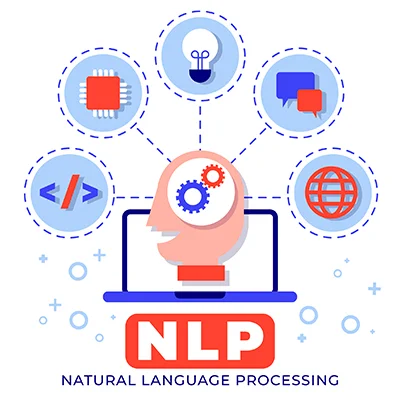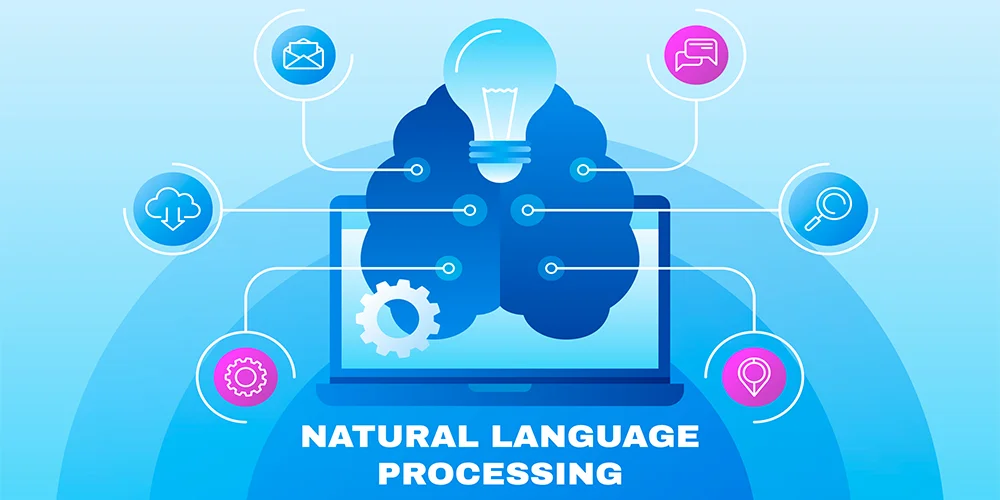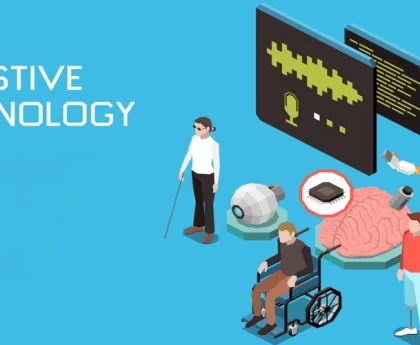Natural Language Processing:(NLP) is a subfield of artificial intelligence (AI) and computational linguistics that focuses on the interaction between computers and human language. It involves the development of algorithms and models that enable machines to understand, interpret, and generate human language in a way that is both meaningful and useful. NLP aims to bridge the gap between the natural, unstructured nature of human language and the structured, logical world of computers, enabling computers to work with text and speech data as humans do.
History of Natural Language Processing:(NLP)
The history of Natural Language Processing (NLP) is a fascinating journey that spans several decades, marked by significant advancements and breakthroughs. NLP is a field of artificial intelligence (AI) and computational linguistics that focuses on enabling machines to understand, interpret, and generate human language.
Here is a brief overview of the key milestones and developments in the history of NLP:
- 1950s-1960s: The Birth of NLP
– The foundations of NLP were laid in the 1950s and 1960s when computer scientists and linguists started exploring the idea of using computers to process and understand human language.
– Early work included attempts to translate languages using rule-based approaches and the development of basic language parsers. - 1970s-1980s: Rule-Based Systems
– During this period, NLP researchers began to develop rule-based systems for parsing and processing text. These systems relied heavily on handcrafted linguistic rules.
– Projects like SHRDLU (developed at MIT) demonstrated early attempts at natural language understanding and interaction with computers. - 1990s: Statistical Approaches
– In the 1990s, statistical approaches gained popularity in NLP. Researchers started using probabilistic models and machine learning techniques to improve language processing tasks such as speech recognition and machine translation.
– Hidden Markov Models (HMMs) and n-grams were some of the statistical methods used. - Late 1990s-2000s: Machine Learning and Corpora
– The availability of large text corpora on the internet and advances in machine learning algorithms led to significant progress in NLP.
– Research shifted towards data-driven methods, including the use of support vector machines (SVMs) and neural networks.
– The introduction of the Penn Treebank and other annotated datasets helped train and evaluate NLP models. - Late 2000s-2010s: Deep Learning and Neural Networks
– The late 2000s and 2010s saw a major transformation in NLP with the rise of deep learning and neural networks.
– Models like Recurrent Neural Networks (RNNs) and Convolutional Neural Networks (CNNs) were applied to various NLP tasks, including sentiment analysis, text generation, and machine translation.
– The introduction of word embeddings (e.g., Word2Vec, GloVe) improved the representation of words in NLP models. - 2018-Present: Transformers and Pre-trained Models
– The most significant breakthrough in recent NLP history has been the introduction of Transformers, a deep learning architecture that revolutionized the field.
– Pre-trained language models like BERT, GPT-2, and GPT-3 achieved state-of-the-art results in a wide range of NLP tasks, including question answering, language translation, and text summarization.
– Transfer learning became a dominant approach, where models are pre-trained on large text corpora and fine-tuned for specific tasks. - Ongoing Challenges and Developments
– While NLP has made remarkable progress, challenges such as bias in language models, ethical concerns, and multilingual understanding remain ongoing areas of research and development.
– Continued efforts are being made to improve NLP models’ interpretability, fairness, and robustness.
The history of NLP reflects a continuous evolution from rule-based systems to data-driven approaches and, more recently, the dominance of deep learning and pre-trained models. NLP has found applications in various fields, including information retrieval, virtual assistants, sentiment analysis, healthcare, and more, and it continues to play a vital role in advancing human-computer interaction and understanding of natural language.
Types of Natural Language Processing:(NLP)
Natural Language Processing (NLP) encompasses a wide range of tasks and applications aimed at understanding, processing, and generating human language.
Here are some of the key types of NLP tasks and applications:
- Text Classification and Categorization:
– Sentiment Analysis: Determining the emotional tone of a piece of text (e.g., positive, negative, neutral).
– Topic Classification: Assigning documents or text to predefined categories or topics.
– Spam Detection: Identifying and filtering out spam or unsolicited emails/messages. - Named Entity Recognition (NER): Identifying and classifying entities within text, such as names of people, organizations, locations, dates, and more.
- Machine Translation: Translating text from one language to another automatically, as seen in applications like Google Translate.
- Speech Recognition: Converting spoken language into written text, enabling voice commands, transcription services, and voice assistants like Siri and Alexa.
- Text Generation: Creating human-like text or speech based on input data, used in chatbots, content generation, and even creative writing.
- Information Extraction: Extracting structured information from unstructured text, such as extracting data from news articles or web pages.
- Question Answering: Building systems that can understand questions posed in natural language and provide relevant answers, as seen in search engines and virtual assistants.
- Summarization: Automatically generating concise summaries of longer texts, such as news articles or research papers.
- Language Modeling: Creating probabilistic models of language to predict the likelihood of a sequence of words, often used as the foundation for various NLP tasks.
- Text Clustering and Similarity Analysis: Grouping similar documents or pieces of text together based on their content or semantic similarity.
- Dialog Systems and Chatbots: Developing systems that can engage in natural language conversations with users, offering customer support or interactive experiences.
- Sentiment Analysis: Analyzing text to determine the sentiment or opinion expressed, often used in social media monitoring and customer feedback analysis.
- Language Understanding and Parsing: Analyzing the grammatical structure and meaning of sentences, including tasks like dependency parsing and constituency parsing.
- Text-to-Speech (TTS): Converting text into spoken language, enabling applications like screen readers and voice assistants.
- Language Generation: Generating coherent and contextually appropriate text, often used in chatbots, content generation, and storytelling.
- Cross-lingual NLP: Extending NLP models to work with multiple languages, including translation, sentiment analysis, and information retrieval.
These are just some of the many types of NLP tasks and applications, and the field continues to evolve with ongoing research and development, making natural language processing a crucial component of modern technology and communication.
-

Natural Language Processing: (NLP)
Benefits of Natural Language Processing:(NLP)
Natural Language Processing (NLP) offers a wide range of benefits and has a significant impact on various industries and applications.
Here are some of the key benefits of NLP:
- Improved Human-Computer Interaction: NLP enables more natural and intuitive interactions between humans and computers, such as voice assistants and chatbots, making it easier for people to access information and services.
- Efficient Information Retrieval: NLP improves search engines and information retrieval systems, helping users find relevant information quickly and accurately.
- Enhanced Customer Support: Chatbots and virtual assistants powered by NLP can provide automated customer support, answer frequently asked questions, and handle routine tasks, reducing the workload on human agents.
- Multilingual Communication: NLP facilitates communication across languages by providing automated translation and language understanding, breaking down language barriers in business and global communication.
- Text Summarization: NLP can automatically generate concise summaries of lengthy documents, saving time for readers and making large volumes of text more manageable.
- Sentiment Analysis: Businesses and organizations use sentiment analysis to understand public sentiment and customer opinions, allowing them to make data-driven decisions and improve products or services.
- Content Generation: NLP can assist in content creation by automatically generating text for articles, reports, or social media posts, increasing content production efficiency.
- Data Extraction: NLP can extract structured information from unstructured text, making it valuable for tasks like data mining, competitive analysis, and information synthesis.
- Personalized Recommendations: NLP-powered recommendation systems analyze user behavior and preferences to offer personalized product recommendations, improving user engagement and sales.
- Medical and Healthcare Applications: NLP assists in analyzing medical records, extracting valuable insights, and automating medical transcription, contributing to improved healthcare outcomes.
- Legal and Compliance: In the legal industry, NLP helps with contract analysis, legal research, and document review, streamlining processes and improving accuracy.
- Financial Analysis: NLP can analyze financial news and reports, helping financial analysts and traders make informed decisions in real-time.
- Education and E-Learning: NLP aids in the development of educational tools and chatbots for personalized learning experiences, student support, and automated grading.
- Public Safety and Security: NLP is used in monitoring and analyzing social media and news for early detection of public safety threats and security incidents.
- Accessibility: NLP technology assists individuals with disabilities by providing text-to-speech, speech-to-text, and other accessibility features.
- Market Research: NLP helps in analyzing customer feedback, social media discussions, and online reviews, providing insights into consumer preferences and trends.
- Efficient Data Processing: NLP automates data entry, document classification, and data extraction tasks, reducing human error and increasing productivity.
- Data Privacy and Compliance: NLP can help organizations comply with data privacy regulations by automatically identifying and protecting sensitive information in documents.
Overall, NLP has the potential to enhance productivity, decision-making, and user experiences across a wide range of industries, making it a valuable technology in the modern world.
Features of Natural Language Processing:(NLP)
Natural Language Processing (NLP) is a multifaceted field with a wide range of features and capabilities.
Here are some of the key features and components of NLP:
- Tokenization: Tokenization is the process of breaking down text into individual words, phrases, or tokens. It’s the fundamental step in text analysis.
- Part-of-Speech (POS) Tagging: POS tagging assigns grammatical categories (e.g., noun, verb, adjective) to each token in a text, providing information about the word’s function in a sentence.
- Named Entity Recognition (NER): NER identifies and classifies named entities in text, such as names of people, organizations, locations, dates, and more.
- Parsing: Parsing involves analyzing the grammatical structure of sentences to determine their syntactic relationships, including dependency parsing and constituency parsing.
- Semantic Analysis: Semantic analysis focuses on understanding the meaning of words, phrases, and sentences in a given context. It’s crucial for tasks like sentiment analysis and natural language understanding.
- Sentiment Analysis: Sentiment analysis determines the emotional tone or sentiment expressed in text, classifying it as positive, negative, or neutral.
- Machine Translation: Machine translation involves automatically translating text from one language to another, enabling cross-lingual communication.
- Text Generation: NLP can generate human-like text based on input data, facilitating content generation and chatbot responses.
- Information Retrieval: NLP plays a role in search engines and information retrieval systems, helping users find relevant information based on their queries.
- Question Answering: Question answering systems are designed to understand natural language questions and provide relevant answers based on structured or unstructured data.
- Speech Recognition: Speech recognition converts spoken language into written text, enabling voice commands and transcription services.
- Text Summarization: NLP can automatically generate concise summaries of longer texts, making content more digestible.
- Language Modeling: Language modeling involves building probabilistic models of language, which are essential for various NLP tasks, including speech recognition and machine translation.
- Cross-lingual NLP: Cross-lingual NLP extends NLP capabilities to multiple languages, including translation, sentiment analysis, and information retrieval.
- Dialog Systems and Chatbots: Dialog systems enable natural language conversations between humans and machines, used in customer support and virtual assistants.
- Text Clustering and Similarity Analysis: NLP can group similar documents or pieces of text together based on content or semantic similarity, aiding in content organization and recommendation systems.
- Text-to-Speech (TTS): TTS technology converts text into spoken language, enabling applications like screen readers and voice assistants.
- Language Understanding: Language understanding models aim to comprehend the context and meaning of sentences, helping machines make sense of human communication.
- Contextual Analysis: NLP models can consider the context of words or phrases in a text to better understand their meanings and relationships.
- Ethical and Bias Detection: NLP can be used to detect biases and ethical concerns in text data, promoting responsible AI and fairness.
These features and components of NLP are essential for various applications across industries, from healthcare and finance to customer service and entertainment, making NLP a versatile and impactful field of study.

Why is NLP difficult?
Natural Language Processing (NLP) is considered difficult for several reasons, despite significant advancements in recent years.
Here are some of the key challenges and complexities that make NLP a challenging field:
- Ambiguity in Language: Natural languages are inherently ambiguous. Words and phrases can have multiple meanings depending on context, making it challenging for machines to accurately interpret and generate language.
- Context Sensitivity: Understanding language often requires considering the broader context of a conversation or text. The same word or phrase can have different meanings in different contexts.
- Idioms and Colloquialisms: Languages are rich with idiomatic expressions and colloquialisms that are challenging for machines to interpret correctly.
- Syntax and Grammar Variations: Natural languages have complex grammatical rules, and variations in syntax, grammar, and sentence structure exist across languages and dialects.
- Word Sense Disambiguation: Determining the correct meaning of a word with multiple senses in context can be difficult. For example, “bank” could refer to a financial institution or the side of a river.
- Lack of Standardization: Language use varies widely, and there are few strict rules governing it. This lack of standardization makes it challenging to create one-size-fits-all NLP models.
- Data Sparsity: While vast amounts of text data are available, much of it is unstructured and may not cover specific domains or languages, leading to challenges in building robust models.
- Out-of-Distribution Data: NLP models may encounter data that differs significantly from the training data, making it challenging to generalize effectively.
- Domain-Specific Language: Different domains (e.g., medicine, law, finance) have their own specialized vocabularies and language conventions, requiring domain-specific NLP models.
- Multilingual Challenges: Handling multiple languages and language pairs introduces additional complexities, such as translation and language-specific nuances.
- Ethical and Bias Concerns:
– NLP models can inadvertently perpetuate biases present in training data, leading to ethical concerns and fairness issues. - Computational Complexity: Many NLP tasks, such as machine translation or large-scale language modeling, are computationally intensive and require substantial resources.
- Interpretable Models: Ensuring that NLP models are interpretable and can provide explanations for their decisions is an ongoing challenge.
- Resource-Intensive Training: Training state-of-the-art NLP models often requires vast amounts of data and computational power, limiting accessibility to researchers and organizations without extensive resources.
- Real-Time Processing: Some NLP applications, like real-time language translation or chatbots, require low-latency processing, which can be technically challenging.
Despite these challenges, NLP has made significant progress, thanks to advances in deep learning and the availability of large datasets. Researchers and practitioners continue to work on addressing these difficulties and improving the capabilities of NLP systems, making them increasingly useful in various applications and industries.
What is interesting about natural language processing?
Natural Language Processing (NLP) is a fascinating and dynamic field with several aspects that make it inherently interesting:
- Human-Machine Interaction: NLP enables more natural and intuitive interactions between humans and computers. This has led to the development of virtual assistants like Siri and chatbots, making technology more accessible and user-friendly.
- Understanding Human Language: NLP seeks to bridge the gap between human language, which is unstructured and ambiguous, and the structured world of computers. Achieving this understanding is a profound and challenging goal.
- Multilingual Communication: NLP allows for seamless communication across languages and cultures. Translation and cross-lingual understanding are not only practical but also culturally enriching.
- Real-World Applications: NLP has a wide range of practical applications across industries, from healthcare and finance to customer service and entertainment. It has the potential to transform how businesses operate and how individuals interact with technology.
- Text Analysis and Insight: NLP can analyze vast amounts of text data to extract valuable insights. It’s used for sentiment analysis, trend detection, and understanding public opinion, contributing to data-driven decision-making.
- Creative Language Generation: NLP can generate creative and contextually relevant language, making it a tool for content creation, storytelling, and even art generation.
- Ethical and Fair AI: NLP raises important ethical questions about bias in language models and the responsibility of AI developers. Researchers are actively working on making AI systems fairer and more accountable.
- Cross-Disciplinary Collaboration: NLP is a cross-disciplinary field, drawing from linguistics, computer science, machine learning, and cognitive science. This interdisciplinary nature fosters collaboration and innovation.
- Rapid Advancements: NLP is a rapidly evolving field, with new breakthroughs and models emerging frequently. Keeping up with the latest developments is intellectually stimulating.
- Challenges and Problem-Solving: NLP is inherently challenging due to language’s complexity, ambiguity, and cultural nuances. Tackling these challenges and solving real-world problems in NLP is intellectually rewarding.
- Accessibility and Inclusivity: NLP technologies can improve accessibility for individuals with disabilities, providing text-to-speech, speech-to-text, and other assistive features.
- Cultural and Linguistic Diversity: NLP recognizes and accommodates the rich linguistic diversity across the world, allowing for the preservation and study of languages and dialects.
- Language Evolution: NLP models can track and understand how language evolves over time, reflecting societal changes, slang, and linguistic trends.
- Natural Language Understanding: Building machines that can understand context, humor, sarcasm, and emotion in human language is an ongoing challenge that makes NLP interesting and ever-evolving.
- Human-Centered AI: NLP technologies aim to make AI more human-centered, adapting to human communication styles rather than forcing humans to adapt to machine interfaces.
In summary, NLP is interesting due to its potential to transform communication, its real-world applications, the ethical questions it raises, its interdisciplinary nature, and its ongoing challenges and advancements. It is a field that constantly pushes the boundaries of what machines can do in terms of understanding and generating natural language.
Internet of Things: (IoT) Benefits & Building The Urban Future





